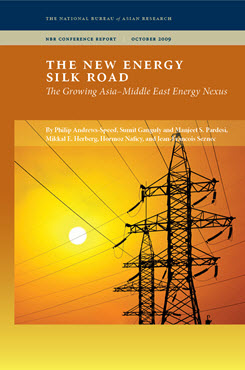NBR Project Report
The New Energy Silk Road
The Growing Asia-Middle East Energy Nexus
This report explores the historic shift in energy trade and relations between Asia and the Middle East through four essays commissioned for the 2009 Energy Security Conference focused on the key state players in this growing nexus of energy and political ties: China, India, Saudi Arabia, and Iran. The report also includes a review of the discussion of long-term U.S. energy and strategic interests, as well as the energy and diplomatic roles of Japan, Korea, and Russia in the Middle East.
This report from NBR’s 2009 Energy Security Conference presents key findings and explores the historic shift in energy trade and relations between Asia and the Middle East. Included in the report are the four essays commissioned for the conference focused on the key state players in this growing nexus of energy and political ties: China, India, Saudi Arabia, and Iran. The report also includes a review of the discussion of long-term U.S. energy and strategic interests, as well as the energy and diplomatic roles of Japan, Korea, and Russia in the Middle East.
Table of Contents
The New Energy Silk Road: The Growing Asia–Middle East Energy Nexus
Mikkal E. Herberg
China’s Energy Role in the Middle East and Prospects for the Future
Philip Andrews-Speed
Prospects for India’s Energy and Geopolitical Roles in the Middle East
Sumit Ganguly and Manjeet S. Pardesi
Energy and Trade Relations between China and Saudi Arabia: A Continuing Evolution
Jean-Francois Seznec
Iran’s Views on the Future of Energy Relations with China and Asia
Hormoz Naficy
The New Energy Silk Road: Implications for the United States
Mikkal E. Herberg
2009 Energy Security Conference Agenda


